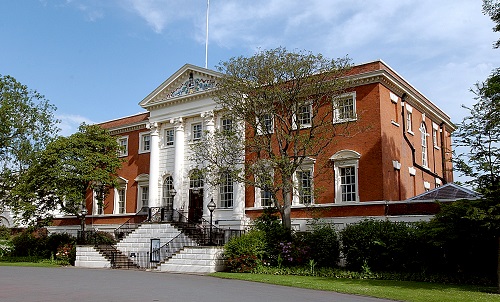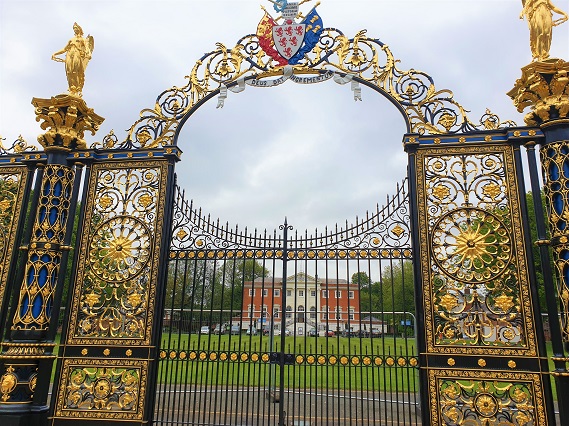The inside
The foyer
The entrance hall to the building is spacious and contains a fine stone chimney-piece.
The mosaic floor was put down in 1902, replacing an original wooden one. It was laid by skilled Italian craftsmen who left a little secret in the floor before they returned to their own country. If you look closely you can find four sets of initials let into the floor. They are JWP for John Wilson Patten, TL for Thomas Longdin (the borough engineer), QV for Queen Victoria who granted Warrington's charter as a borough in 1847 and LW for (James) Lyon Whittle who was Town Clerk in 1902.
There are painted coats of arms over the various doors leading from the foyer, which are part of the original decoration.
The Council Chamber
The room now used as the Council Chamber was originally two rooms - the great hall and the music room. The centre shield over the door to the chamber is that of William Patten of Dagenham, Bishop of Winchester, Lord High Chancellor of England in 1456 and founder of Magdalen College, Oxford. Those on each side of it are also very early arms of the family.
The room is now used for committee meetings and other council and civic activities, and it can be hired for conferences, weddings and other events.
The Mabel Capper Room
Previously known as Committee Room 2, the Mabel Capper Room is at the east end of the Council Chamber and was originally the ladies retiring room. It’s now used for council meetings.
Committee Room 1
Committee Room 1 was the old dining room. The shield over the door represents the arms of Thomas Patten, son of the builder.
The room is now used for council meetings, and it holds the gallery of historic silver plates and other civic regalia.
Mayor’s Parlour
The room now used as the Mayor's Parlour was originally a reading room. The shield over the door is that of Thomas Wilson Patten, grandson of the builder and father of John Wilson Patten, Lord Winmarleigh, the last owner.
The top floor
The rooms on the upper floor of the hall, now used as offices, were bedrooms, changing rooms, bathrooms and toilets.
The ground floor
The kitchens, as now, were situated on the ground floor along with store and servants' rooms.
The cellar
Extensive cellars still provide good dry storage accommodation, and were originally used primarily for wine and food.
The architect, James Gibbs
Contemporary manuscripts show that James Gibbs, the builder of the Radcliffe Library at Oxford and many other great works, was the architect and builder of the house – and from its dating, it’s likely that it was the last important building built to his designs and finished in his lifetime.
The Patten family
The name of Patten dominates the industrial and social history of Warrington up to the late 19th century.
The family originated in Chelmsford, Essex, in about 1119. One member, William, was the founder of Magdalene College Oxford, Bishop of Winchester, and Chancellor of England in 1456.
Another branch of the family arrived in Warrington in 1536 from Derbyshire and by the middle of the 17th century had settled in Patten Lane, off Bridge Street, as merchants dealing in a wide range of commodities including tobacco, sugar and tea.
The father of the builder of Bank Hall, also a Thomas Patten, realised the river was important to make Warrington a key distribution point for inland trade. He made it navigable from Runcorn to Bank Quay, meaning copper could be brought by boat from Ireland, Cornwall and Anglesey right to the family's smelting works at Bank Quay. The Patten fortune was largely built on the infamous slave trade as their works produced copper bangles traded for slaves in Africa and great coppers used to boil sugar and distil rum in the West Indies.
This industry was so successful that by the mid-18th century, the Pattens weren’t just local merchants, but important and landed gentry. And so in 1750, James Gibbs was commissioned to build a fine country house. Dr Richard Pocock, the well-known 18th century traveller who was later Bishop of Ossory, wrote that as he was passing through Warrington on 14 July 1750, he saw Thomas Patten Esq. busy building this house.
The name Wilson was linked with Patten when Mary Patten married the Rev. Thomas Wilson D.D. in 1698. Thomas Wilson became Bishop of Soder and Man, and in recognition of his services to the island's sovereign, the Earl of Derby, he acquired considerable lands in Lancashire and Cheshire which, on the death of his only son, passed to the Patten family on condition that the additional surname was used.

